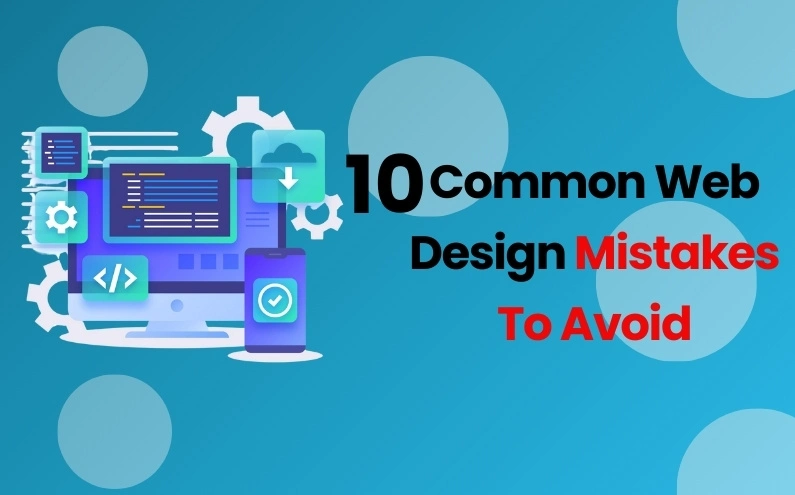errors should be avoided:
1. Overcomplicated Design
Keep It Simple
A common mistake in web design is creating an overcomplicated layout. Despite the allure of utilizing the newest technologies and design trends, a cluttered design might confuse customers. To ensure a user-friendly experience, simplicity is essential. Focus on clean lines, ample white space, and a logical layout that guides users intuitively through the site.
Avoid Clutter
Too many elements on a single page can confuse visitors. Give information and features that are crucial to the goal of your website top priority. Ensure each page has a clear focal point and remove any unnecessary distractions.
2. Poor Navigation
Intuitive Navigation
It should be simple and quick for users to find what they’re looking for. Complicated or unclear navigation menus can frustrate visitors and drive them away. Ensure your navigation is intuitive by using clear, concise labels and logical groupings.
Consistent Layout
Consistency in navigation layout across all pages helps users feel oriented and comfortable. Use standard positions for menus, such as a top or side bar, and keep the structure uniform throughout the site.
3. Non-Responsive Design
Mobile Optimization
A responsive design is essential due to the rising use of mobile devices. A non-responsive website can alienate a large portion of your audience. Ensure your site is mobile-friendly by using a responsive design framework that adapts to various screen sizes and orientations.
Test Across Devices
Regularly test your website on different devices and browsers to ensure it performs well everywhere. Mobile usability problems can be found and fixed with the aid of resources like Google’s Mobile-Friendly Test.
4. Slow Load Times
Optimize Performance
Users expect fast-loading websites. Slow load times can lead to higher bounce rates and lower engagement. Improve the speed of your website by using browser caching, minifying CSS and JavaScript, and compressing pictures.
Use Content Delivery Networks (CDNs)
A CDN can improve load times by serving content from servers closer to the user’s geographic location. This lowers latency and expedites the transmission of content from your website.
5. Lack of Clear Call-to-Action (CTA)
Define Clear CTAs
Every page on your website should have a clear purpose and guide users toward a specific action. If there aren’t any obvious calls to action, users may not know what to do next. Use prominent, well-designed buttons and links to direct users towards desired actions, such as signing up, purchasing, or contacting you.
Make CTAs Stand Out
Make sure the colors and positioning of your call-to-actions (CTAs) contrast to make them visually striking. They should be easy to find and click on, guiding users seamlessly through the conversion process.
6. Poor Readability
Optimize Typography
Readability is crucial for user engagement. Poor font choices, small text sizes, and insufficient contrast can make your content difficult to read. Choose legible fonts, use appropriate sizes, and ensure there’s enough contrast between text and background.
Break Up Text
Large blocks of text can be intimidating and hard to digest. Break up content with headings, subheadings, bullet points, and images to make it more scannable and engaging.
7. Ignoring SEO Best Practices
SEO Integration
Designing a website without considering SEO can limit its visibility in search engines. Integrate SEO best practices into your design process by optimizing meta tags, headings, and images. Ensure your site has a logical structure and use internal linking to improve crawlability.
Use Descriptive URLs
Descriptive, keyword-rich URLs can improve your site’s SEO and help users understand what a page is about before they click on it. Avoid using generic or overly complex URLs.
8. Inconsistent Design Elements
Maintain Brand Consistency
Inconsistent design elements can make your site look unprofessional and confuse users. Utilize a consistent color scheme, font, and design on all pages to retain brand consistency. This promotes trust and brand familiarity.
Create a Style Guide
A style guide can help ensure consistency in design elements. Document your choices for colors, fonts, button styles, and other design components so that everyone involved in your site’s development adheres to the same standards.
9. Ignoring Accessibility
Design for All Users
Accessibility is crucial for ensuring that all users, including those with disabilities, can use your website. Ignoring accessibility might cause legal problems and alienate a sizable percentage of your audience. To make your website accessible, adhere to the Web Content Accessibility Guidelines (WCAG).
Use Alt Text and ARIA Labels
Provide alternative text for images and use ARIA (Accessible Rich Internet Applications) labels to make interactive elements accessible to screen readers. Ensure your site can be navigated using a keyboard for users with mobility impairments.
10. Lack of User Testing
Conduct Regular User Testing
Designing a website without user testing can result in a poor user experience. Regularly conduct user testing to gather feedback and identify usability issues. Make informed design decisions and enhancements by utilizing this input.
A/B Testing
Comparing two iterations of a webpage to see which works better is known as A/B testing. This can help you make data-driven decisions about design changes and optimize your site for user engagement and conversions.

